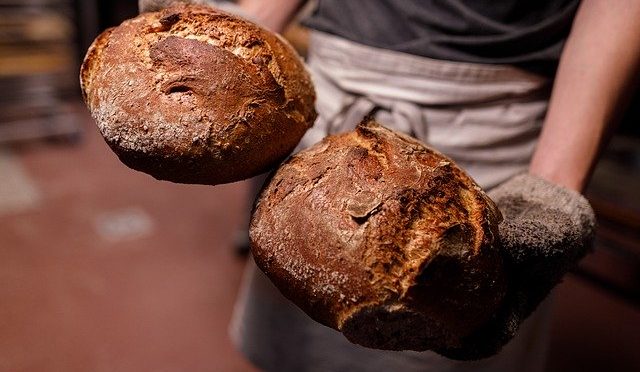3 c Bread or all-purpose flour
1 pk Dry yeast
1 ts Sugar
1 ts Salt
1/4 c Instant potato flakes
1 1/2 c Hot water; 120-130 degrees
1/2 Stick butter or margarine;
-melted
2 Eggs
4 oz Swiss cheese; coarsely
-grated
From: RobieLynn@aol.com (RobieLynn)
Date: Mon, 16 Jan 1995 11:53:34 +0000
Recipe By: Bernard Clayton – The Complete Book of Breads – Page 337
Equipment: One 8″ tube pan (angel food, bundt, or guegelhupf), greased or
Teflon; 1 baking sheet.
By Hand or Mixer: Measure 1 1/2 cups flour into a large mixing or mixer
bowl and stir in the yeast, sugar, salt, potato flakes, and hot water. Beat
by hand 30 strong strokes, or for 1 minute in the mixer. Add the melted
butter or margarine, eggs, and Swiss cheese. Beat by hand 100 strokes, or
for 2 minutes with the mixer turned to high. Stop the mixer. Stir in the
balance of the flour, 1/2 cup at a time, first with the spoon and then by
hand, or with the mixer flat beater and then dough hook. The dough will be
a rough, shaggy mass that will clean the sides of the bowl. However, if it
continues to be slack (wet), add small portions of flour. Kneading (8
minutes): Turn the dough onto a lightly floured work surface and knead with
the rhythmic motion of push-turn-fold. Add light sprinkles of flour if
necessary. In the mixer, with the dough hook, the dough will completely
clean the sides of the bowl and form a ball around the revolving hook. The
dough will be smooth and elastic. Knead by hand or mixer for 8 minutes.
First Rising (1 hour): Place the dough in a greased mixing bowl and pat
with buttered or greased fingers. Cover the bowl tightly with plastic wrap
and leave at room temperature until the dough has doubled in volume, about
1 hour. (If prepared with a new fast-rising yeast and at the recommended
higher temperatures, reduce the rising times by about half.) Shaping (6
minutes): Punch down the dough, turn it onto the floured work surface, and
let it rest for 2 minutes. It can be shaped in one of two ways. One is to
roll it under your palms to about 20 inches in length. Lay the length of
dough in the prepared pan. Overlap the ends slightly and pinch together.
Or, flatten the ball of dough and, with your fingers, punch a hole in the
center and widen this to slip over the tube. Either way, push the dough
firmly into the bottom of the pan.
Second rising (45 minutes): Cover the pan with a length of foil or wax
paper and let rise until the dough has doubled in volume, 45 minutes.
Preheat the oven to 375 degrees 20 minutes before baking. (If using a
convection oven, reduce heat by 50 degrees.) Place the pan in the moderate
oven. Bake until a metal skewer inserted in the center of the loaf comes
out clean and dry, about 45 minutes. Ten minutes before the baking is done,
carefully turn the loaf out of the pan onto a baking sheet.
Return to the oven. This will give the loaf a lovely overall brown that it
would not otherwise have. But handle it carefully. It is fragile when hot.
Take the bread from the oven. Slide the loaf off the baking sheet onto a
metal rack to cool before slicing.
NOTES: The author writes, “Swiss cheese melts and spreads through this
handsome and delicious loaf to create a soft and tender slice. Basically a
potato bread, the loaf bakes to a light brown with dark pieces of crusted
cheese melted into the surface.”
REC.FOOD.RECIPES
From rec.food.cooking archives. Downloaded from Glen’s MM Recipe Archive,
Yields
12 Servings
